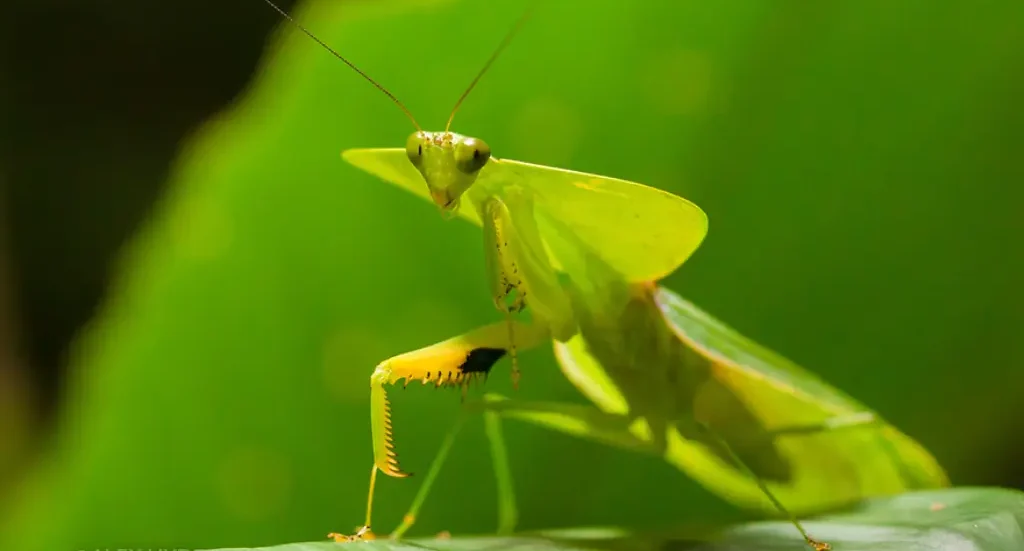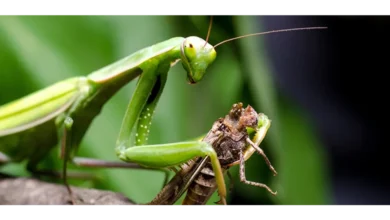Leaf-mimicking mantises are some of the most extraordinary examples of camouflage in the insect world. These mantises have evolved to resemble leaves so closely that they can be nearly indistinguishable from their surroundings.
This mimicry not only helps them avoid predators but also allows them to ambush prey with remarkable efficiency. In this article, we will compare some of the most well-known leaf-mimicking mantis species, exploring their similarities, differences, and the unique adaptations that make each one a master of disguise.
Introduction to Leaf-Mimicking Mantises

Leaf-mimicking mantises are a group of mantises that have evolved to closely resemble leaves, allowing them to blend into their environment. This form of camouflage, known as cryptic mimicry, is so effective that it often renders these mantises virtually invisible to both predators and prey.
These mantises are found in various parts of the world, particularly in tropical and subtropical regions where dense foliage provides ample opportunities for camouflage. The specific adaptations and appearance of each species have evolved to suit their particular habitats, resulting in a fascinating diversity of leaf-mimicking forms.
Dead Leaf Mantis (Deroplatys spp.)
The Dead Leaf Mantis is one of the most famous leaf-mimicking mantises, known for its uncanny resemblance to a dead or decaying leaf.
Key Characteristics:
- Appearance: The Dead Leaf Mantis has a broad, flat body with irregular edges that mimic the shape of a dried leaf. Its coloration ranges from brown to mottled gray, with patterns that resemble veins and spots typically seen on dead leaves.
- Size: This species is relatively large, with females reaching up to 10 cm (4 inches) in length. Males are smaller and more slender.
- Camouflage Strategy: The mantis’s body is designed to blend into leaf litter on the forest floor. When lying motionless among fallen leaves, it is nearly indistinguishable from its surroundings.
- Behavior: This mantis often remains stationary, enhancing its camouflage. When disturbed, it may sway gently to mimic a leaf blowing in the wind.
Habitat and Distribution:
- Natural Habitat: The Dead Leaf Mantis is commonly found in the tropical rainforests of Southeast Asia, particularly in Malaysia, Indonesia, and the Philippines.
- Habitat Preference: It prefers dense, shaded areas with abundant leaf litter, where its camouflage is most effective.
Ghost Mantis (Phyllocrania paradoxa)
The Ghost Mantis is another well-known leaf mimic, distinguished by its delicate, wispy appearance that resembles a withered leaf.
Key Characteristics:
- Appearance: The Ghost Mantis has an elongated, narrow body with leaf-like projections on its head, thorax, and limbs. Its coloration varies from pale green to dark brown, depending on its environment.
- Size: This species is smaller than the Dead Leaf Mantis, with females reaching about 5-6 cm (2-2.5 inches) in length.
- Camouflage Strategy: The Ghost Mantis’s body shape and texture allow it to blend in with dead leaves and twigs. Its irregular outline and the leaf-like projections help break up its silhouette, making it difficult to detect.
- Behavior: This mantis is known for its calm and non-aggressive demeanor. It often remains motionless, relying on its camouflage to avoid detection. When threatened, it may adopt a defensive posture that further enhances its leaf-like appearance.
Habitat and Distribution:
- Natural Habitat: The Ghost Mantis is native to Madagascar and parts of Africa, where it inhabits dry, arid regions with sparse vegetation.
- Habitat Preference: It prefers areas with dry leaves and twigs, where its mimicry is most effective.
Violin Mantis (Gongylus gongylodes)
The Violin Mantis, also known as the Wandering Violin Mantis, is known for its elegant, elongated body that resembles a dried, curled leaf or twig.
Key Characteristics:
- Appearance: The Violin Mantis has a very slender, elongated body with large, flattened limbs that give it the appearance of a dried leaf or twig. Its coloration is typically light brown, with some individuals exhibiting greenish or grayish hues.
- Size: The Violin Mantis is medium to large in size, with females reaching up to 10 cm (4 inches) in length. Males are smaller and more delicate.
- Camouflage Strategy: The mantis’s body shape and coloration allow it to blend in with dry vegetation, particularly in scrubland and open forests. Its limbs are flattened and broad, resembling the curled edges of dried leaves.
- Behavior: The Violin Mantis is a relatively docile species that relies on its camouflage to remain undetected. It is often found perched motionless on branches, mimicking the appearance of dried, curled leaves or twigs.
Habitat and Distribution:
- Natural Habitat: This species is native to India, Sri Lanka, and parts of Southeast Asia, where it inhabits dry forests and scrubland.
- Habitat Preference: The Violin Mantis prefers open, dry environments with sparse vegetation, where its unique body shape and coloration provide effective camouflage.
Shield Mantis (Rhombodera spp.)
The Shield Mantis, also known as the Giant Asian Mantis, is another fascinating species that uses leaf mimicry for camouflage.
Key Characteristics:
- Appearance: The Shield Mantis has a broad, flat thorax that resembles a leaf, with a smooth, green coloration. The “shield” on its back is particularly pronounced, enhancing its leaf-like appearance.
- Size: This species is one of the larger mantises, with females reaching up to 12 cm (5 inches) in length.
- Camouflage Strategy: The Shield Mantis’s coloration and body shape allow it to blend in with foliage, particularly in trees and shrubs. The leaf-like shield on its thorax helps it blend into leaves when viewed from above.
- Behavior: The Shield Mantis is an active hunter that uses its camouflage to ambush prey. It is more aggressive and less likely to rely on motionlessness than other leaf mimics, often stalking prey with deliberate movements.
Habitat and Distribution:
- Natural Habitat: The Shield Mantis is found in Southeast Asia, particularly in countries like Thailand, Malaysia, and Indonesia.
- Habitat Preference: It prefers tropical forests with abundant greenery, where it can effectively blend into the foliage.
Comparison of Leaf-Mimicking Mantises

Camouflage Strategies
- Dead Leaf Mantis: Utilizes a broad, flat body and mottled coloration to mimic dead or decaying leaves on the forest floor. Its camouflage is highly effective in dense, leaf-littered environments.
- Ghost Mantis: Resembles a withered leaf, with delicate projections that enhance its disguise among dry leaves and twigs. Its irregular outline helps break up its silhouette.
- Violin Mantis: Mimics dried, curled leaves or twigs with its slender, elongated body and broad, flattened limbs. Its unique shape is particularly suited to dry, open environments.
- Shield Mantis: Uses a pronounced “shield” on its back and smooth green coloration to mimic living leaves, blending in with foliage in trees and shrubs.
Behavioral Adaptations
- Dead Leaf Mantis: Relies heavily on motionlessness to remain undetected. When disturbed, it may sway gently, mimicking a leaf blowing in the wind.
- Ghost Mantis: Also relies on stillness and a non-aggressive demeanor. It adopts defensive postures that enhance its leaf-like appearance when threatened.
- Violin Mantis: Primarily relies on its body shape and coloration for camouflage but is also known to remain motionless for extended periods to avoid detection.
- Shield Mantis: More active and aggressive than the other species, using its camouflage for ambush hunting rather than solely for defense.
Habitat and Distribution
- Dead Leaf Mantis: Inhabits tropical rainforests in Southeast Asia, favoring areas with dense leaf litter.
- Ghost Mantis: Found in dry, arid regions of Madagascar and Africa, where it blends in with sparse vegetation.
- Violin Mantis: Native to dry forests and scrubland in India, Sri Lanka, and Southeast Asia, where it mimics dried vegetation.
- Shield Mantis: Found in tropical forests of Southeast Asia, preferring areas with abundant foliage.
Evolutionary Significance of Leaf Mimicry
Leaf mimicry in mantises is a prime example of adaptive evolution, where natural selection has favored individuals that closely resemble leaves, enhancing their survival and reproductive success. The diversity in leaf mimicry among mantis species highlights how different environments and ecological pressures can lead to the evolution of similar yet distinct camouflage strategies.
- Predator Avoidance: Leaf mimicry provides a significant advantage in avoiding predation, as it allows mantises to blend into their environment and avoid being detected by birds, reptiles, and other predators.
- Hunting Efficiency: Camouflage also plays a critical role in the mantis’s ability to ambush prey. By remaining hidden, mantises can strike with precision and reduce the risk of prey escaping.
- Diversification: The variety of leaf-mimicking mantis species demonstrates the adaptive radiation that can occur when different populations are subjected to varying ecological conditions, leading to the evolution of specialized forms of camouflage.
Leaf-mimicking mantises are among the most extraordinary examples of camouflage in the natural world. Each species has evolved unique adaptations that allow it to blend seamlessly into its environment, whether it’s the forest floor, dry leaves, or lush foliage. These adaptations are not only a testament to the power of natural selection but also provide valuable insights into the evolutionary processes that shape the diversity of life on Earth.
By comparing the Dead Leaf Mantis, Ghost Mantis, Violin Mantis, and Shield Mantis, we gain a deeper understanding of the different strategies mantises use to survive in their respective habitats. These species continue to captivate scientists and nature enthusiasts alike, offering a fascinating glimpse into the intricate relationships between form, function, and survival in the insect world.



